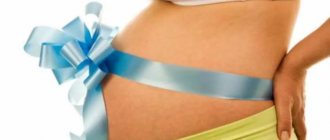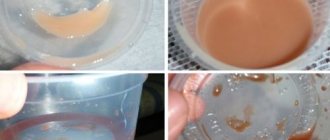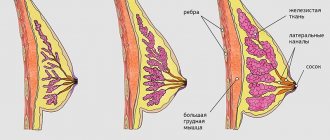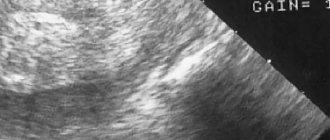The appearance of this fluid in the mammary glands of pregnant women is a preparatory stage for breastfeeding. Colostrum is released as a natural result of hormonal changes in the female body. When does a woman notice his appearance for the first time? What does she need to know about this substance?
What is colostrum
The very name of the liquid indicates its connection with breast milk. It appears under the influence of the female hormone oxytocin. People call it young milk. Its appearance is preceded by an enlargement of the pregnant breast and an increase in its sensitivity. It is during this period that the tubules and ducts of the mammary glands expand.
Colostrum is a sticky, viscous, sweetish liquid. Its color may be yellowish and translucent. The main component of the nutrient fluid is albumin. This protein helps the baby develop. In addition to albumin, colostrum contains globulins, fats, mineral salts, bifidobacteria and lactobacilli, lactose, vitamins A, C, E, PP. The substance also contains amylase, protease, lipase - food enzymes. The basis of the nutrient fluid is water. It contains about 84% of colostrum. The calorie content of the liquid is 150 kcal per 100 ml.
What is it?
As soon as a woman becomes pregnant, her body begins to rebuild and prepare for bearing and giving birth to a baby. These changes affect not only the reproductive organs and hormonal system, but also the mammary glands. Due to fluctuations in hormone levels, painful sensations arise in the breasts, they become engorged, and stretch marks appear. As a rule, such unpleasant symptoms in the mammary glands disappear after the first trimester, but in some girls they persist until childbirth.
Colostrum, which is the first food of a baby, appears in each girl at different times. Some people notice discharge from the breast after the 14th week of pregnancy, others experience this phenomenon already at the very end of pregnancy, and for others it appears immediately after the birth of the baby. All these options are not considered a deviation from the norm and depend on the characteristics of the woman’s body. Colostrum contains many useful components that a baby needs in the first hours of life. Proteins accelerate the development of the digestive system and prepare it to accept milk.
Expert opinion
Perchatkina Galina Viktorovna
Doctor of the highest category. Our best expert.
Ask a Question
But the most useful thing that is in colostrum are antibodies that protect the baby’s body at a time when his own immune system has not yet been formed.
In addition, colostrum contains:
- vitamins: A, B, C, D3, E;
- growth hormones and enzymes;
- minerals: chlorine, chromium, zinc, phosphorus, magnesium, potassium, calcium, iron;
- amino acids and leukocytes.
The nutritional value of colostrum, compared to real mother's milk, is low - 50-55 kcal. However, this calorie content is quite enough for the baby in the first days after birth.
Colostrum from the breast is not pregnant
Colostrum before menstruation
Colostrum usually appears immediately after childbirth and sometimes women experience it even during pregnancy. In the first trimester, the breasts are already preparing for lactation and such discharge is quite natural. However, what to think if the pregnancy test is negative and the woman notices the appearance of colostrum before her period?
Sometimes this indicates changes in hormonal balance. Sometimes this is triggered by taking birth control pills. If you notice that you have colostrum discharge before your period for no apparent reason (no pregnancy), it is advisable to donate blood to check the level of the hormone prolactin. This will help with establishing the causes of the phenomenon.
If you are not pregnant, but colostrum is released from your breasts during menstruation (during or before or after menstruation), this is probably due to one of the diseases of the mammary glands. But before you think about it, rule out all natural causes. Sometimes colostrum is released for several years after breastfeeding ends. Or you are pregnant, but the period is just so small that the test does not show it.
If this is not the case, then you need to look for breast diseases - inflammatory, dyshormonal in nature. Or it may mean the presence of tumors - both benign and malignant.
hormonal imbalance - this increases the risk of developing mammary gland pathology and a woman develops lumps in her breasts, for example, mastopathy;
mastitis - it begins with infection and pain, then lumps appear in the breast, which eventually become purulent. This pus may be discharged from the nipple. This condition is treated with antibacterial drugs and surgery to clean out the pus;
benign tumor (fibroadenoma) – formed due to increased sexual activity
Almost every woman periodically faces a painful condition of the mammary glands. During this period, the chest becomes engorged and becomes very painful. A woman begins to wonder: why do her breasts hurt after ovulation? It seems that there can be no pain, because everything happens in the ovaries and uterus. However, ovulation is a process that can affect all hormone-dependent organs.
Ovulation and its features
Ovulation is a natural process that occurs in the body of any woman. The main result is the release of the egg to the sperm for further fertilization.
The egg matures in the ovary in a period of 8 to 30 days. In the middle of the menstrual cycle (within 12 days), the pituitary gland produces luteinizing hormone in large quantities. Ovulation occurs within 36 hours.
Ovulation occurs instantly. All preceding and subsequent processes relate to the ovulatory period. Its duration may vary depending on the characteristics of the woman’s body.
It is clear that in the case of fertilization, the egg attaches to the wall of the uterus and the development of the fetus occurs. Otherwise, the walls of the uterus are renewed, and menstruation occurs.
All this is accompanied by the release of a large number of hormones, the balance of which helps the woman’s body recognize the phases of the cycle. It turns out that it is the activity of hormones that leads to a woman’s condition when she feels discomfort in the mammary glands, in the abdomen, and feels aching in the lower back and other organs.
Characteristic features of ovulation
There are several signs by which a woman understands that the period of ovulation is approaching. Depending on the individuality of the body, each woman can feel one sign or several.
When does colostrum appear during pregnancy?
Some girls note the appearance of colostrum after conception already in the early stages, while others begin to produce it immediately after childbirth. Such features depend on the woman’s body and do not affect milk production in the future.
It sometimes happens that colostrum begins to be released in the first month after fertilization, and by the last week of pregnancy it disappears and appears again immediately after the birth of the child. If these processes are not accompanied by painful sensations and the release of blood impurities, this does not pose a threat to the girl’s health and does not affect milk production in the future.
There are cases when the first drops of colostrum begin to be released in the second trimester of pregnancy. This is facilitated by taking a warm shower in the summer, massage of the breasts and nipples and strong emotional experiences.
Colostrum before menstruation
Colostrum usually appears immediately after childbirth and sometimes women experience it even during pregnancy. In the first trimester, the breasts are already preparing for lactation and such discharge is quite natural. However, what to think if the pregnancy test is negative and the woman notices the appearance of colostrum before her period?
Sometimes this indicates changes in hormonal balance. Sometimes this is triggered by taking birth control pills. If you notice that you have colostrum discharge before your period for no apparent reason (no pregnancy), it is advisable to donate blood to check the level of the hormone prolactin. This will help with establishing the causes of the phenomenon.
If you are not pregnant, but colostrum is released from your breasts during menstruation (during or before or after menstruation), this is probably due to one of the diseases of the mammary glands. But before you think about it, rule out all natural causes. Sometimes colostrum is released for several years after breastfeeding ends. Or you are pregnant, but the period is just so small that the test does not show it.
If this is not the case, then you need to look for breast diseases - inflammatory, dyshormonal in nature. Or it may mean the presence of tumors - both benign and malignant.
hormonal imbalance - this increases the risk of developing mammary gland pathology and a woman develops lumps in her breasts, for example, mastopathy;
mastitis - it begins with infection and pain, then lumps appear in the breast, which eventually become purulent. This pus may be discharged from the nipple. This condition is treated with antibacterial drugs and surgery to clean out the pus;
benign tumor (fibroadenoma) - formed due to increased activity of sex hormones. This mobile tumor is removed
Source
Properties and characteristics of colostrum at different periods
After conception, a woman’s body begins to produce the hormone prolactin, which stimulates the production of colostrum. The first signs of the appearance of this nutrient are sometimes observed as early as 5-6 weeks after fertilization.
In the early stages, colostrum does not have much nutritional value, but by the end of the gestation period it is saturated with useful substances and vitamins necessary for adequate nutrition of the baby in the first days after birth. When a woman wears tight underwear, colostrum begins to flow in small streams, so it is important to choose a larger bra size.
Composition and nutritional value
Colostrum differs from regular milk not only in color and consistency, but also in chemical composition.
It contains little liquid, which has a beneficial effect on the work of the newborn’s immature kidneys, which are not yet ready for overload. Everything is assimilated, there is nothing to be released yet.
The nutrient density is several times higher, since its task is the immune protection of the newborn. Calorie content 100 gr. Colostrum in the first day after birth is 150 kcal.
On the first day, the protein in colostrum is 6%, mainly globulin and albumin - they pass through the intestinal walls and are easily digested. The composition of amino acids is almost the same as in the mother's blood serum.
By the fifth day of feeding, the energy value gradually decreases to 70 kcal, “transitional milk” (mixed with colostrum) and then “mature milk” are released. The protein content has decreased to 1-2%, and it is mainly casein - it is more difficult to digest and curdles in the stomach.
Colostrum contains
- t-lymphocytes (more than in the blood); immunoglobulin A; neutrophils;
- natural antioxidants (vitamins A, B, C, E, PP; beta-carotene; selenium; zinc);
- mineral salts;
- trace elements (cobalt, iron, copper);
- water;
- simple proteins, fats and carbohydrates (lactoferrin, lactose, etc.);
- food enzymes (protease, amylase, lipase);
- lactobacilli and bifidumbacteria.
Many of the components mentioned are designed to strengthen the baby's immunity. Most of them ( lactoferrin, immunoglobulin A ) are not digested, so they remain in the stomach, where they are able to fight allergens and other harmful substances.
A number of beneficial properties for a child
- Influence on the development of microflora of the small intestine. Populates it with the necessary bifidobacteria and lactobacilli . Such flora promotes the absorption of milk and adapted formulas, accelerates the maturation of the epithelium and allows for complete bowel movements;
- Acceleration of the excretion of the first feces (meconium), thanks to the laxative properties of colostrum. After removing the original dark feces from the rectum, the baby’s body is ready to receive mature mother’s milk;
- Enriching the child's body with vitamins, minerals and antioxidants. These beneficial substances are necessary for the formation and development of organs.
- Saturation of the baby's body with immune cells. Lactoferrin; lymphocytes; live leukocytes-macrophages, immunoglobulin A; neutrophils. They are secreted from colostrum, are not digested or absorbed, but remain in the gastrointestinal tract and protect the baby’s body from harmful environmental microorganisms. They provide the newborn with passive immunity, since he will learn to develop his own only after 6 months of life.
- Removes excess bilirubin. What prevents the baby from developing physiological jaundice.
- Protects against oxygen stress due to its high content of natural antioxidants.
- Provides antiviral protection and prevents the attachment of many bacteria. Antiviral protection occurs thanks to leukocytes that produce interferon. Oligosaccharides and polysaccharides prevent bacteria from attaching to mucous membranes.
According to official studies, it is known that colostrum (colostrum) is effective against various bacteria (E. coli, salmonella, streptococcus, etc.). Colostrum actively fights rotaviruses or polio and herpes viruses.
What does a selection look like?
At first it is a clear, colorless and odorless liquid. Closer to childbirth, the color of colostrum changes to yellow, and the consistency becomes viscous. However, the baby's first feed is clearer than the intermediate milk that follows. Typically, colostrum continues to be produced for 2 days after the baby is born.
Deviation from the norm
If the production of colostrum is accompanied by painful sensations, inclusions of blood or pus, this is a reason to consult a mammologist.
Feels the pain
Painful sensations accompanied by nipple discharge can be caused by various diseases, including:
- ductal papilloma;
- endocrine disorders;
- mammary cancer;
- Paget's disease of the breast;
- mastitis;
- abscess;
- perudactal mastitis.
All these cases require immediate diagnosis and treatment, as they pose a threat to the woman’s life.
Blood trails
As a rule, colostrum mixed with brownish inclusions appears in primiparous women. Typically, this phenomenon is observed in the early stages and is associated with stretching of the milk ducts. In addition, hormonal changes occur in the body, which can also lead to such discharge. However, there are other causes of brown discharge that require medical intervention:
- Blockage of milk ducts.
- A neoplasm of a malignant or benign nature.
- Inflammation of the mammary glands.
Discharge mixed with blood is also a consequence of hypothermia, infection and microtrauma.
Unpleasant smell
During the normal development of pregnancy, the smell of the emerging colostrum is slightly sweet, reminiscent of the aroma of milk. If the discharge from the mammary glands smells unpleasant, this indicates the development of some kind of disease: infectious or oncological.
In this case, consultation with a mammologist is necessary to prevent complications.
If colostrum is released in non-pregnant women
Since the appearance of colostrum is not a symptom of pregnancy, why does a woman have a secretion if she is not pregnant? Firstly, if such a phenomenon occurs, you must immediately make an appointment with a mammologist. This phenomenon often indicates the presence of dangerous changes in a woman’s body, such as hormonal imbalance, mastitis, or mammary tumors.
Secondly, sometimes the reasons for the appearance of such a secret are not dangerous. For example, some ladies note that before menstruation, sticky fluid begins to secrete from their nipples, which doctors associate with an increase in prolactin concentration, which causes the temporary appearance of colostrum. Sometimes such a reaction is a consequence of taking hormonal contraception.
Can it occur in the absence of pregnancy?
Discharge from the mammary glands in the absence of pregnancy indicates the presence of diseases:
- When the breast is injured and there is strong compression, discharge from the mammary glands occurs.
- Grayish purulent discharge indicates the presence of infectious diseases.
- With mastopathy, the hormonal balance in the body is disrupted, and the concentration of prolactin increases sharply. Because of this, discharge oozes from the nipples, accompanied by painful sensations.
- With galactorrhea, the process of milk production starts even in the absence of pregnancy.
- Tumors provoke discharge interspersed with blood.
In addition, a physiological secretion accumulates in a woman’s breast, which is released when the nipple is pressed. This condition is not pathological and does not pose a threat to the health and life of the girl.
What should you do if you leak colostrum?
It is strictly forbidden to squeeze colostrum from the breast during pregnancy. This provokes uterine contractions and leads to miscarriage or premature birth. If copious secretions are accompanied by pain in the lower abdomen, you should visit a doctor, as these are also signs of a pregnancy disorder.
Expert opinion
Perchatkina Galina Viktorovna
Doctor of the highest category. Our best expert.
Ask a Question
During the period of colostrum production, a woman needs to properly care for her breasts to avoid infection.
Hygiene rules
If you do not wash your breasts every day in the morning and evening with water at room temperature, the colostrum will dry out and begin to tighten the breasts, causing discomfort due to burning and itching. During water procedures, the use of chemicals that irritate the skin and nipples is not recommended. After washing, wipe the breasts with a soft terry towel; do this carefully, without applying much effort.
Underwear and pads
During the period of bearing a child, it is recommended to wear only underwear made from natural fabrics. Artificial bras irritate the skin and do not allow air to pass through. Bras are chosen so that they do not squeeze the mammary glands, but are spacious. To avoid staining clothes with colostrum, purchase special pads for bras. To maintain a feeling of freshness, they are changed several times a day.
Strengthening procedures
To keep the skin on your chest elastic and firm, it is useful to take air baths. Every day a woman should remove her bra and allow the mammary glands to air for 15-20 minutes.
Another strengthening procedure is a contrast shower. It is taken daily before bed, using a nozzle that creates a medium-intensity pressure.
Cosmetics for care
To care for the mammary glands during pregnancy, choose cosmetics that do not contain parabens and silicones, which irritate the skin. For shower, purchase a gel with natural ingredients in its composition. Typically, such products are marked “For pregnant and lactating women.”
To prevent stretch marks from appearing on the chest, purchase a special cream. They prefer water-based products over oil-based ones, as they are quickly absorbed and do not stain clothes. It is better to use oil creams and lotions in the evening before bed and give them time to absorb.
About colostrum after childbirth
In the first hours after the birth of the baby, it is placed on the mother's breast. The first drops of colostrum are very important for its development and the formation of the digestive system. Some mothers worry that a few drops of colostrum will not be enough for the baby to be full, but this is not the case. Colostrum is very nutritious, and the first days after birth such food is enough for the baby. 2 days after birth, intermediate milk appears in the woman’s breast, and after another 5 days, full milk, which the baby is fed with as long as possible, without switching to artificial feeding.











